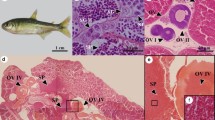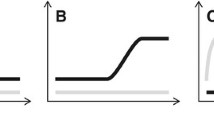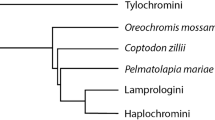Abstract
Total synaptonemal complex (SC) lengths were estimated from Oreochromis aureus Steindachner (which has a WZ/ZZ sex determination system), O. mossambicus Peters and O. niloticus L. (both of which have XX/XY sex determination systems). The total SC length in oocytes was greater than that in spermatocytes in all three species (194 ± 30 μm and 134 ± 13 μm, 187 ± 22 μm and 127 ± 17 μm, 193 ± 37 μm and 144 ± 19 μm, respectively). These sex-specific differences did not appear to be influenced by the type of sex determination system (the female/male total SC length ratio was 1.45 in O. aureus, 1.47 in O. mossambicus and 1.34 in O. niloticus) and do not correlate with the lack of any overall sex-specific length differences in the current Oreochromis linkage map. Although based on data from relatively few species, there appears to be no consistent relationship between sex-specific SC lengths and linkage map lengths in fish. Neomale (hormonally masculinized genetic female) O. aureus and O. mossambicus had total SC lengths of 138 ± 13 μm and 146 ± 13 μm respectively, more similar to normal males than to normal females. These findings agree with data from other vertebrate species that suggest that phenotypic sex, rather than genotype, determines traits such as total SC length, chiasmata position and recombination pattern, at least for the autosomes.

Similar content being viewed by others
Abbreviations
- ANOVA:
-
Analysis of variance
- ET:
-
17∝-Ethynyltestosterone
- Male-T:
-
Genetic males treated with ET or MT
- MT:
-
17∝-Methyltestosterone
- SC:
-
Synaptonemal complex
- SCTL:
-
Synaptonemal complex total length
- TSD:
-
Temperature sex determination
References
Artieri CG, Mitchell LA, Ng SHS et al (2006) Identification of the sex-determining locus of Atlantic salmon (Salmo salar) on chromosome 2. Cytogenet Genome Res 112:152–159
Cal RM, Vidal S, Martinez P et al (2006) Growth and gonadal development of gynogenetic diploid Scophthalmus maximus. J Fish Biol 68:401–413
Calderon PL, Pigozzi MI (2006) MLH1-focus mapping in birds shows equal recombination between sexes and diversity of crossover patterns. Chromosome Res 14:605–612
Campos-Ramos R, Harvey SC, Masabanda JS et al (2001) Identification of putative sex chromosomes in the blue tilapia, Oreochromis aureus, through synaptonemal complex and FISH analysis. Genetica 111:143–153
Campos-Ramos R, Harvey SC, McAndrew BJ et al (2003) An investigation of sex determination in the Mozambique tilapia, Oreochromis mossambicus, using synaptonemal complex analysis, FISH, sex reversal and gynogenesis. Aquaculture 221:125–140
Carrasco LAP, Penman DJ, Bromage N (1999) Evidence for the presence of sex chromosomes in the Nile tilapia (Oreochromis niloticus) from synaptonemal complex analysis of XX, XY and YY genotypes. Aquaculture 173:207–218
Chistiakov DA, Hellemans B, Haley CS et al (2005) A microsatellite linkage map of the European sea bass Dicentrarchus labrax L. Genetics 170:1821–1826
Coimbra MRM, Kobayashi K, S Koretsugu et al (2003) A genetic linkage map of the Japanese flounder, Paralichthys olivaceous. Aquaculture 220:203–218
Cuñado N, Terrones J, Sánchez L et al (2001) Synaptonemal complex analysis in spermatocytes and oocytes of turbot, Scopthalmus maximus (Pisces, Scopthalmidae). Genome 44:1143–1147
Cuñado N, Barrios J, San Miguel E et al (2002) Synaptonemal complex analysis in oocytes and spermatocytes of threespine stickleback Gasterosteus aculeatus (Teleostei, Gasterosteidae). Genetica 114:53–56
Danzmann RG, Cairney M, Davidson WS et al (2005) A comparative analysis of the rainbow trout genome with 2 other species of fish (Arctic charr and Atlantic salmon) within the tetraploid derivative Salmonidae family (subfamily: Salmoninae). Genome 48:1037–1051
Ezaz MT, Harvey SC, Boonphakdee C et al (2004) Isolation and physical mapping of sex-linked AFLP markers in the Nile tilapia (Oreochromis niloticus L.). Mar Biotechnol 6:435–445
Franch R, Louru B, Tsalavouta M et al (2006) A genetic map of the hermaphrodite teleost fish Sparus aurata L. Genetics 174:851–861
Gharbi K, Gautier A, Danzmann RG et al (2006) A linkage map for brown trout (Salmo trutta): chromosome homeologies and comparative genome organization with other salmonid fish. Genetics 172:2405–2419
Iwai T, Yoshii A, Yokota T et al (2006) Structural components of the synaptonemal complex, SYCP1 and SYCP3, in the medaka fish Oryzias latipes. Exp Cell Res 312:2528–2537
Kondo M, Nagao E, Mitani H et al (2001) Differences in recombination frequencies during female and male meioses of the sex chromosomes of the medaka, Oryzias latipes. Genet Res 78:23–30
Kondo M, Hornung U, Nanda I et al (2006) Genomic organization of the sex-determining and adjacent regions of the sex chromosomes of medaka. Genome Res 16:815–826
Lee BY (2004). Approach to the identification of sex-determining genes in the tilapia genome by genetic mapping and comparative positional cloning. PhD Thesis, University of New Hampshire. 135 pp
Lee BY, Penman DJ, Kocher TD (2003) Identification of a sex-determining region in Nile tilapia (Oreochromis niloticus) using bulked segregant analysis. Anim Genet 34:379–383
Lee BY, Hulata G, Kocher TD (2004) Two unlinked loci controlling the sex of blue tilapia (Oreochromis aureus). Heredity 92:543–549
Lorch PD (2005) Sex differences in recombination and mapping adaptations. Genetica 123:39–47
Lynn A, Koehler KE, Judis L et al (2002) Covariation of synaptonemal complex length and mammalian meiotic exchange rates. Science 296:2222–2225
Lynn A, Schrump S, Cherry J et al (2005) Sex, not genotype, determines recombination levels in mice. Am J Hum Genet 77:670–675
Majumdar KC, McAndrew BJ (1986) Relative DNA content of somatic nuclei and chromosomal studies in three genera Tilapia, Sarotherodon, and Oreochromis of the tribe Tilapiini (Pisces, Cichlidae). Genetica 68:175–188
Matsuda M, Nagahama Y, Shinomiya A et al (2002) DMY is a Y-specific gene required for male development in the medaka fish. Nature 417:559–563
Melard C (1995) Production of a high percentage of male offspring with 17α ethynylestradiol sex-reversed Oreochromis aureus. I. Estrogen sex-reversal and production of F2 pseudofemales. Aquaculture 130:25–34
Moen T, Hoyheim B, Munck H et al (2004) A linkage map of Atlantic salmon (Salmo salar) reveals an uncommonly large difference in recombination rate between the sexes. Anim Genet 35:81–92
Oliveira C, Foresti F, Rigolino MG et al (1995) Synaptonemal complex analysis in spermatocytes and oocytes of rainbow trout, Oncorhynchus mykiss (Pisces, Salmonidae)—the process of autosome and sex-chromosome synapsis. Chromosome Res 3:182–190
Peichel CL, Ross JA, Matson CK et al (2004) The master sex-determination locus in threespine sticklebacks is on a nascent Y chromosome. Curr Biol 14:1416–1424
Penman DJ, McAndrew BJ (2000) Genetics for the management and improvement of cultured tilapias. In: Beveridge MCM, McAndrew BJ (eds) Tilapias: biology and exploitation. Kluwer, Dordrecht, pp 227–266
Peterson DG, Stack SM, Healy JL et al (1994) The relationship between synaptonemal complex length and genome size in four vertebrate classes (Osteicthyes, Reptilia, Aves, Mammalia). Chromosome Res 2:153–162
Samollow PB, Kammerer CM, Mahaney SM et al (2004) First-generation linkage map of the gray, short-tailed opossum, Monodelphis domestica, reveals genome-wide reduction in female recombination rates. Genetics 166:307–329
Singer A, Perlman H, Yan YL et al (2002) Sex-specific recombination rates in zebrafish (Danio rerio). Genetics 160:649–657
Sun F, Oliver-Bonet M, Liehr T et al (2004) Human male recombination maps for individual chromosomes. Am J Hum Genet 74:521–531
Tease C, Hulten MA (2004) Inter-sex variation in synaptonemal complex lengths largely determine the different recombination rates in male and female germ cells. Cytogenet Genome Res 107:208–215
Traut W, Winking H (2001) Meiotic chromosomes and stages of sex chromosome evolution in fish: zebrafish, platyfish and guppy. Chromosome Res 9:659–672
Waldbeiser GC, Bosworth BG, Nonneman DJ et al (2001) A microsatellite-based linkage map for channel catfish, Ictalurus punctatus. Genetics 158:727–734
Wallace BMN, Wallace H (2003) Synaptonemal complex karyotype of zebrafish. Heredity 90:136–140
Wallace H, Wallace BMN, Badawy GMI (1997) Lampbrush chromosomes and chiasmata of sex-reversed crested newts. Chromosoma 106:526–533
Acknowledgements
RCR was supported by a PhD grant from Consejo Nacional de Ciencia y Tecnologia (CONACYT) and CIBNOR, Mexico. SCH was supported by a research grant from BBSRC, awarded to DJP and colleagues. We would like to thank several colleagues for provision of unpublished information (as indicated) and comments on the Discussion, and Mr. Keith Ranson and Mr. William Hamilton for assistance with maintenance of fish stocks.
Author information
Authors and Affiliations
Corresponding author
Rights and permissions
About this article
Cite this article
Campos-Ramos, R., Harvey, S.C. & Penman, D.J. Sex-specific differences in the synaptonemal complex in the genus Oreochromis (Cichlidae). Genetica 135, 325–332 (2009). https://doi.org/10.1007/s10709-008-9280-8
Received:
Accepted:
Published:
Issue Date:
DOI: https://doi.org/10.1007/s10709-008-9280-8




